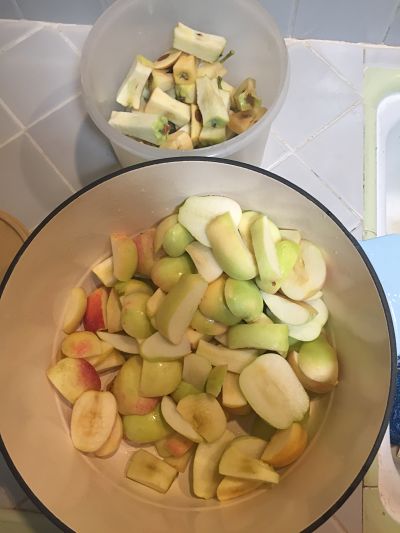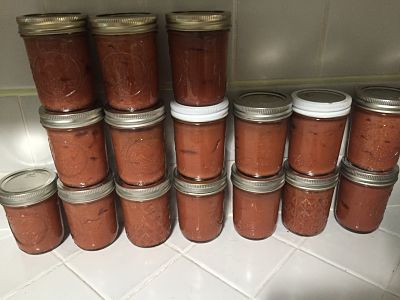Way Too Many Apples!!!
Part 1: Applesauce
By Farmer Greg Peterson
When nature is really in balance (this usually happens in my yard when I stand back and let nature be), the abundance is mind blowing. And that is exactly what I have right now with apples…so many that I am not sure I can process them all.

Some people think that I only teach about gardening and permaculture, but as I have aged my way through life and have begun to understand the workings of nature a little better, I have learned a lot about wealth. Not necessarily financial wealth, but the true wealth of nature and when I take time to observe, I see an amazing level of abundance in my yard. This month it is in the form of apples…hundreds and hundreds in all sizes from teeny to jumbo.
The mystery is what to do with all these apples? The first rule of dealing with nature’s extreme abundance is to have a plan and the tools in place for when it arrives. At the Urban Farm this year’s crop of apples will get converted into applesauce, cider, wine (oh yeah), and chips all that will last me nicely through the year. The upside is that I have a nice crop of preserved apples…the big challenge is having the right tools, making the time, and having the talent to get it done. Getting the right tools can be a little pricey, but once you do that you will have them for decades; the rest is really all about discipline, experimenting and learning.
So let’s dive in to part 1 and look at my apple preserving process…
Applesauce is one of Heidi’s favorites and not only do we eat it right out of the jar—it also makes a great oil or butter replacement in baking. This recipe is much easier, as it doesn’t require you to peel the fruit, an arduous process especially with small apples. Plus, it makes an incredible creamy product.
For this batch, we needed 6 pounds of apples, a Dutch oven, cinnamon, cloves and sugar, then if you are jarring it you will need the jars, lids and either a pressure or bath canner. Click HERE for the full recipe.
Our apples were sweeter than most so I decided not to add sweetener up front, waiting until I could taste the finished product before adding sugar. The cool thing is the longer the apples stay on the trees the sweeter they get and my second batch, two weeks after the first one, required a lot less sugar.
The first step is to wash and core the apples (about 20 minutes for this task). I loaded them directly into the Dutch oven, added the cinnamon and stuck them in the oven.


Next year I am going to borrow mom’s solar oven and try cooking them in it.
Once done, I pulled it out of the oven and let them cool. It just seemed easier than trying to use the food processor while the apples were hot. Step two was to spoon them into the food processor and run it till the apples came out creamy with NO lumps. This took about three minutes and skins and pulp were reduced to this amazing, a little bit tart, very creamy apple sauce.
To address the tartness, I heated a cup of water added a half cup of sugar (I used honey on the second batch) until it was liquefied, then folded that into the pureed apples. It was just enough sweetness to make the sauce perfect. Then, per my canning recipe, I jarred the mixture and processed the jars to current National Center for Home Food Preservation specifications, which is really important for health and safety. And once the jars cooled and sealed we were ready for storing in the pantry.

Stay tuned next week for steps two and three where I outline how to press apples for cider (juice) and dehydrate them.
Greg Peterson is a green living and sustainability innovator who is well-known regionally. He has appeared extensively on local television and radio and is a frequent guest columnist for publications. His mission is “inspire people to embrace their own greenness,” which he does daily by living what he speaks. He received his master’s degree in Urban and Environmental Planning (MUEP) in December 2006 from Arizona State University.







Greg,
Again, great timing for letting us know what to do with the abundance.
What kind of apples do you have that are ripening this time of year? I thought all apples liked cooler weather, but apparently I was mistaken!
Amanda – Great Question and I need to clear this up for people in the article. We are in Phoenix and the two types that do well here are the Dorsett Golden and Anna Apples. They are ripe and off the tree by July 1 otherwise they cook on the trees in our heat. Generally in cooler climates though apples do come in the fall.
I just finished canning 16 pints of apple butter from my Dorsett Golden–delish!